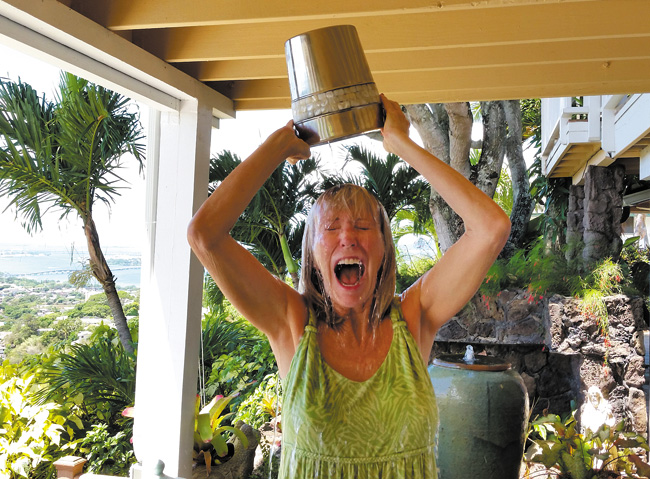Taking On The ‘Ice Bucket Challenge’
Mike Ford is my first cousin. We call him Big Mike, partly because of his big heart of gold, but more because he’s 6-foot-3 and used to weigh in at about 350, a one-time advantage for the former Rice University football lineman.
But that was before ALS, the dreaded “Ice Bucket Challenge” disease, slimmed him down. Mike loves to eat, but now, a year after his diagnosis, it’s very hard to swallow. In no time his food will come solely from a feeding tube.
ALS is the debilitating, deadly, neuromuscular disease most people had never heard of before the ALS Ice Bucket Challenge went wildly viral across social media. With celebrities and regular folk alike dumping buckets of ice water on their heads on YouTube and Facebook, while shivering out a challenge to friends and family to do the same and to include a $100 donation, ALS has finally gotten the recognition it deserves — and the money it needs.
Close to $100 million in donations have come to ALS Foundation in just a month’s time — almost 100 times more than was donated during the same period last year.
In a darkly ironic twist, just three years ago Mike’s younger sister Carol lost her husband, Mark Rylander, to ALS after a valiant two-year battle. Big Mike would’ve been the first to raise a bucket over his head for such a challenge to honor brother-in-law Mark, but today Mike can’t move his arms at all.
Our family was shocked that our close-knit clan would have two family members with ALS, a fairly uncommon, hard-to-pronounce disease. (A genetic “familial” form of ALS is what beloved Hawaii artist Peggy Chun succumbed to, but Mike’s isn’t that type.)
The als.org website defines it: “Amyotrophic lateral sclerosis, often referred to as Lou Gehrig’s disease, is a progressive neurodegenerative disease that affects nerve cells in the brain. … America’s military veterans are approximately twice as likely to develop ALS than other segments of our population.”
Little was known about ALS until New York Yankees great Lou Gehrig made his famous “luckiest man on the face of the earth” speech. Gehrig, 37, a lefty, power-hitting first-baseman and six-time World Series winner, faced a crowd in Yankee stadium 75 years ago in 1939, as he resigned from the sport:
“Fans, for the past two weeks you have been reading about the bad break I got. Yet today I consider myself the luckiest man on the face of the earth. I have been in ballparks for 17 years and have never received anything but kindness and encouragement from you fans.”
He went on to count the blessings of knowing the greats of baseball, teammates, managers, owners. “Sure, I’m lucky. When the New York Giants, a team you would give your right arm to beat, and vice versa, sends you a gift — that’s something. When everybody down to the groundskeepers and those boys in white coats remember you with trophies — that’s something. When you have a wonderful mother-in-law who takes sides with you in squabbles with her own daughter — that’s something. When you have a father and a mother who work all their lives so that you can have an education and build your body — it’s a blessing. When you have a wife who has been a tower of strength and shown more courage than you dreamed existed — that’s the finest I know. So, I close in saying that I might have been given a bad break, but I’ve got an awful lot to live for.” (He died in 1941.)
That same inspiring attitude is common with those I’ve known with the disease — Peggy, Mark, Mike, Charlie Wedemeyer. I only can conclude that God anoints them with a special gift of grace — even humor — under the cruelest of circumstances. When I saw Mike last May, he sardonically quipped, “Well, at least I’ve lost weight.”
It’s an expensive disease, too. The cost of a specially equipped wheelchair with an eye-recognition computer for communication costs more than $60,000, not to mention 24/7 care of minding every human need, such as transporting a 6-foot-3 man with no use of his limbs.
When asked where this new flood of donations should go, Dr. Richard Bedlack, director of the Duke Institute for Brain Sciences ALS clinic, believes that rather than for research, the money should go to patient care and quality of life, his “No. 1 priority.” I believe it should be shared, for what is life without hope?
So with both trepidation and conviction, in honor of Big Mike, I challenge all readers to take the ALS Ice Bucket Challenge, including you, Don Chapman and Ron Nagasawa, and send your photos and videos to my Facebook page — and donate, please.
To participate in the Ice Bucket Challenge, go to mda.org. To make a donation, go to alsa.org.
susanpagecoffee@gmail.com






